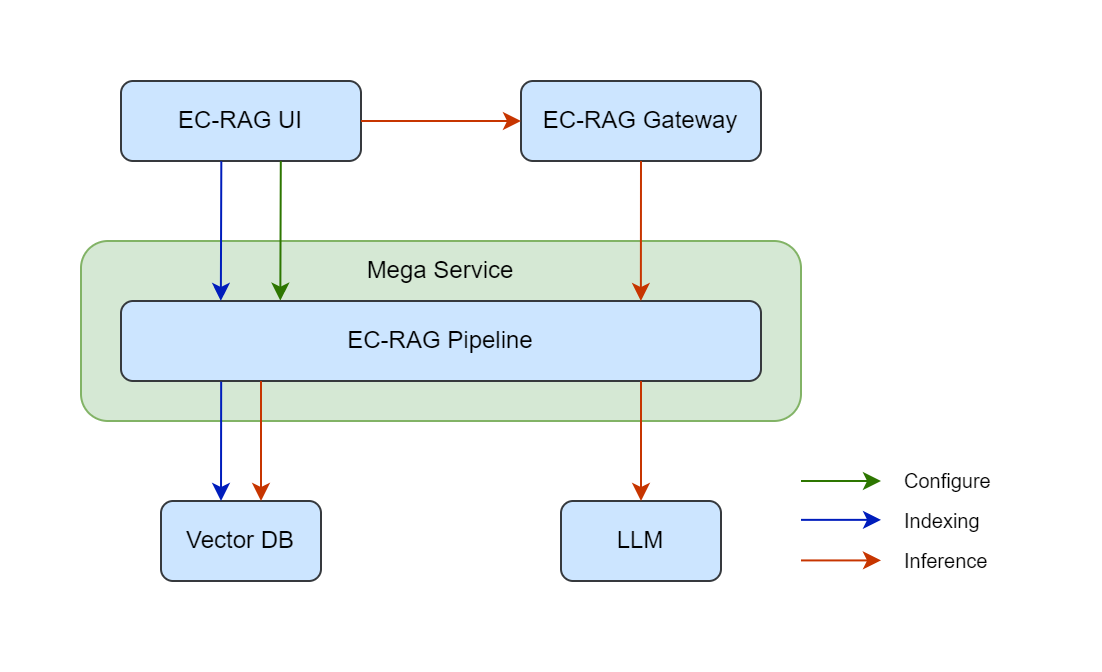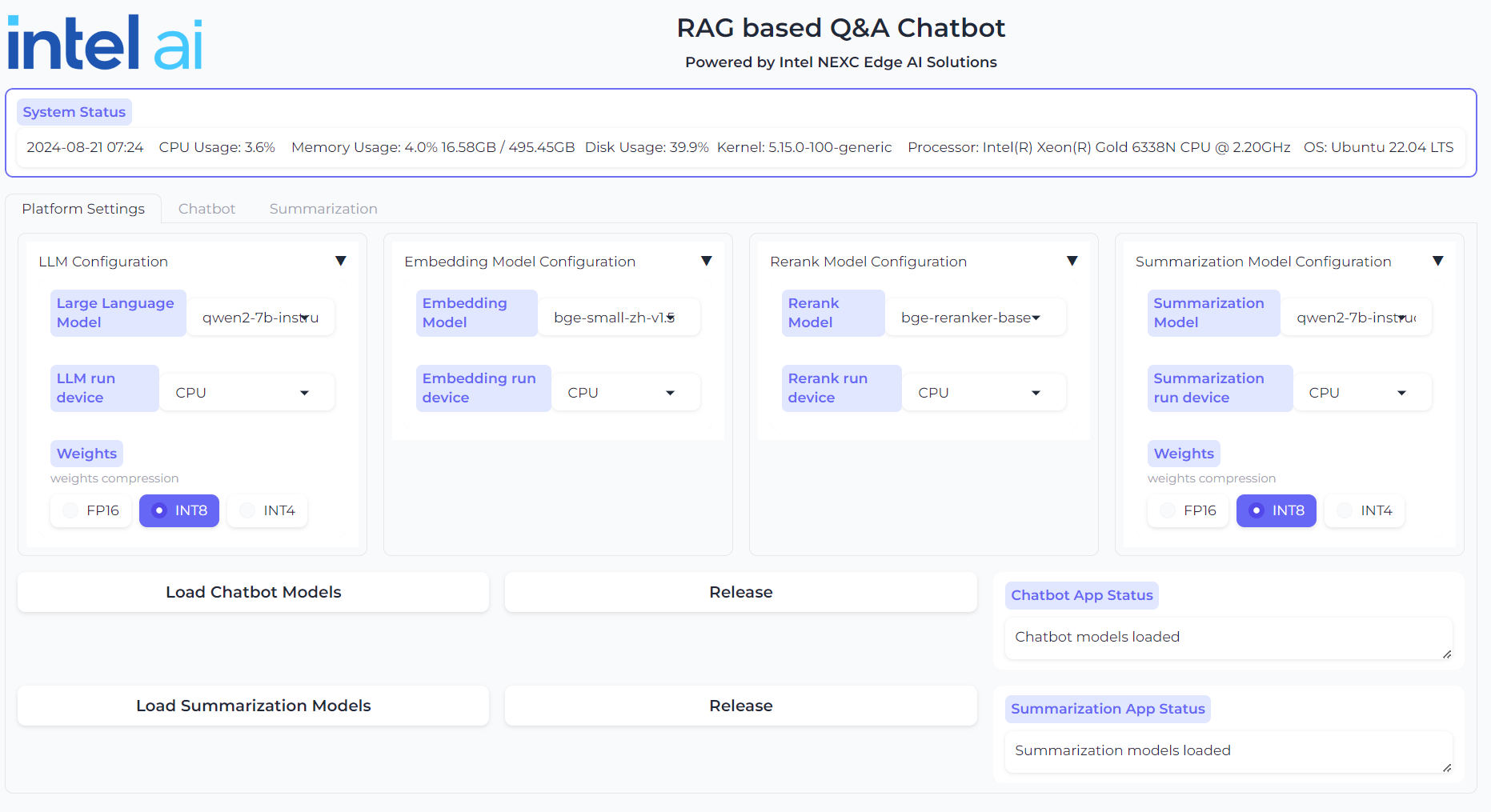24-08-21-GenAIExample-002-Edge Craft RAG¶
This RFC describes a solution of a tunable RAG for edge scenarios.
Status¶
Under Review
Objective¶
Edge industry users are facing obstacles to build an “out-of-the-box” RAG application to meet both quality and performance requirements. Total Cost of Ownership(TCO) and pipeline optimization techniques are the two main reasons to block this process.
Total Cost of Ownership¶
The HW requirement of a typical edge use case is a single host with one of the following combinations:
Intel(R) Core(TM) Ultra Processor
Intel(R) Core(TM) Processor + Intel(R) Iris(R) Xe Graphics
Intel(R) Core(TM) Processor + Intel(R) Arc(TM) A-Series Graphics
Intel(R) Xeon(R) Processor + Intel(R) Arc(TM) A-Series Graphics
The scenarios with these hardware options block the edge users from using large parameter size LLMs on-prem as well as sophisticated RAG pipeline for their data. Thus, the RAG pipeline at edge needs to be highly curated for underlying hardwares and suitable models accordingly.
RAG Pipeline Optimization Techniques¶
Tuning RAG pipeline is a systematic problem. First, the quality depends on the result of each stage in the pipeline as well as the end-to-end outcome. Second, optimization could be a trade-off among the metrics. It is difficult to decide one answer is better than another if it is slightly not accurate in number but more relevant to the query. Third, the optimization techniques may not intuitively reflect to metrics improvements. E.g., recrusive retrieval may contribute to improving the recall and context relevancy, or may not.
Motivation¶
Edge Craft RAG (EC-RAG) is a customizable, tunable and production-ready Retrieval-Augmented Generation system for edge solutions. It is designed to curate the RAG pipeline to meet hardware requirements at edge with garanteed quality and performance.
From quality perspective, EC-RAG is tunable in the indexing, retrieving, reranking and generation stages for particular edge use cases. From performance perspective, the pipeline is consolidated in a single service to eliminate the overhead of inter-service communication on a single host. Meanwhile, the inferencing stages like embedding, reranking and generation are optimized for Intel(R) Iris(R) Xe Graphics and Intel(R) Arc(TM) A-Series Graphics.
Design Proposal¶
EC-RAG is composed of the following components:
UI for doc loading and interactive chatbot.
Gateway
Mega-service with a single micro-services for the tunable* EC-RAG pipeline.
LLM serving microservice optimized for Intel(R) Iris(R) Xe Graphics and Intel(R) Arc(TM) A-Series Graphics
VectorDB microservice optimized for Intel(R) Iris(R) Xe Graphics and/or Intel(R) Arc(TM) A-Series
Docker compose file to launch the UI, Mega/Micro-services
[!NOTE] *Advanced tuning EC-RAG will need a tool co-piloting with the pipeline which will be described in a separate doc
Below diagram illustrates the overall components of EC-RAG:

The EC-RAG pipeline will expose 3 types of REST API endpoint:
/v1/data for indexing
/v1/settings for configuration
/v1/chatqna for inferencing
/v1/data¶
Description |
Action |
Endpoint |
Data Schema |
|---|---|---|---|
Upload a file |
POST |
/v1/data |
FastAPI.UploadFile |
List files |
GET |
/v1/data |
|
Remove |
DELETE |
/v1/data/{id} |
/v1/settings/pipelines¶
Description |
Action |
Endpoint |
Data Schema |
|---|---|---|---|
Setup a pipeline |
POST |
/v1/settings/pipelines |
Pipeline object |
Get/list pipelines |
GET |
/v1/settings/pipelines(/{id}) |
Pipeline object(s) |
Update pipelines |
PATCH |
/v1/settings/pipelines/{id} |
Pipeline object |
Remove a pipeline |
DELETE |
/v1/settings/pipelines/{id} |
/v1/settings/models¶
Description |
Action |
Endpoint |
Data Schema |
|---|---|---|---|
Load models |
POST |
/v1/settings/models |
Model object |
Get/list models |
GET |
/v1/settings/models(/{id}) |
Model object(s) |
Update models |
PATCH |
/v1/settings/models/{id} |
Model object |
Remove a model |
DELETE |
/v1/settings/models/{id} |
Pipeline configuration example¶
{
"name": "rag_demo",
"node_parser" : {
"chunk_size": 250,
"chunk_overlap": 48,
"type": "simple"
},
"indexer": {
"type": "faiss_vector",
"model": {
"model_id": "BAAI/bge-small-en-v1.5",
"model_path": "./bge_ov_embedding",
"device": "auto"
}
},
"retriever": {
"type": "vectorsimilarity",
"top_k": 30
},
"postprocessors": [
{
"type": "reranker",
"rerank_top_n": 5,
"model": {
"model_id": "BAAI/bge-reranker-large",
"model_path": "./bge_ov_reranker",
"device": "auto"
}
}
],
"generator": {
"model": {
"model_id": "qwen2-7b-instruct",
"model_path": "./qwen2-7b-instruct/INT4_compressed_weights",
"device": "auto"
},
"prompt_path" : "./data/default_prompt.txt"
},
"active": "True"
}
UI¶
The EC-RAG UI is gradio. The user is able to select the models as well as input parameters in different stages for the pipeline. The chatbox is also integrated in the UI.
EC-RAG UI - Model Condiguration

EC-RAG UI - Chatbot with settings

Compatibility¶
EC-RAG megaservice and microservice are compatible with the existing OPEA GenAIExamples and GenAIComps repos. The EC-RAG leverages the LLM microservice and the VectorDB microservice from GenAIComps.
Miscellaneous¶
The EC-RAG will be developed in 2 phases.
Phase 1¶
The UI, gateway, and EC-RAG pipeline will be finished without Vector DB as persistent DB. Instead, FAISS will be used for vector search and keep vector store in memory.
In this phase, the LLM inferencing will happen in the pipeline until the LLM serving microservice supports Intel(R) Iris(R) Xe Graphics and Intel(R) Arc(TM) A-Series Graphics.
Phase 2¶
The vector DB will be enabled in this phase as well as LLM inferencing on Intel(R) Iris(R) Xe Graphics and Intel(R) Arc(TM) A-Series Graphics.